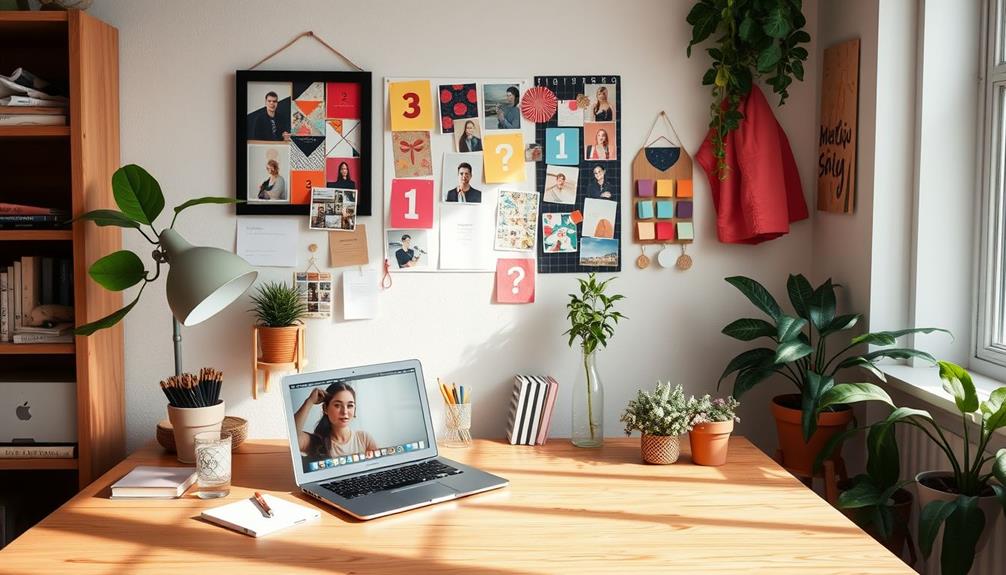Creating an interior design portfolio without experience is doable by focusing on your personal projects. Start by redecorating spaces or styling areas in your home. Document each step—include before-and-after photos, sketches, and mood boards. This shows your creativity and problem-solving skills. Build an online presence with a professional website or social media accounts where you can showcase high-quality images of your work. Don't forget to network with others in the field; attending events or joining online communities can open doors. If you explore various techniques, you'll discover even more ways to enhance your portfolio. For additional inspiration and guidance, seek out interior design portfolio examples online. Analyzing successful portfolios can help you understand what clients and employers look for in a designer’s work. By incorporating elements that stand out in these examples, you can further elevate your own portfolio and attract potential opportunities. With dedication and perseverance, even a novice designer can create a compelling portfolio that showcases their talent and potential.
Key Takeaways
- Start with personal design projects to create tangible examples of your skills and style for the portfolio.
- Document your design process with sketches, mood boards, and before-and-after photos to showcase problem-solving abilities.
- Build a professional website to serve as a digital portfolio, including high-quality images and project descriptions.
- Showcase a diverse range of work to highlight versatility and adaptability in different design styles and approaches.
- Engage with the design community through social media and networking events to gain exposure and potential opportunities.
Understanding Portfolio Types
When you're diving into interior design, understanding the different types of portfolios is fundamental for showcasing your skills effectively. You'll encounter several portfolio types, each serving a unique purpose.
A graduate portfolio is your first step; it's a collection of your academic work designed to impress potential employers after university. This hardcopy or digital format highlights your design skills and achievements.
Next, consider a CV portfolio. This type focuses on relevant examples from your professional experiences, tailored to specific job applications. It emphasizes the skills and qualities that match employers' needs, making it essential when you're applying for jobs.
Then, there's the professional portfolio, which is important for attracting paying clients. This can take the form of a website or social media account, showcasing your unique style and the services you offer.
Building your portfolio digitally is increasingly popular, as it allows for high-quality images and engaging layouts.
Understanding portfolio types will help you create a tailored approach for showcasing your work, whether you're just starting or looking to attract clients. Each portfolio type is a stepping stone in your interior design career.
Importance of a Portfolio

A strong portfolio is vital for anyone pursuing a career in interior design. It serves as a visual resume that showcases your design skills and creativity, helping you stand out in a competitive field. A well-curated portfolio highlights your unique strengths and personal style, attracting the clients and projects you desire.
By including personal projects, you can illustrate your capabilities even without prior client experience, showcasing authenticity and your unique selling propositions (USPs).
Moreover, a professional portfolio demonstrates your technical skills and versatility, which are essential for gaining trust from potential employers or clients. It allows you to present your best work and make a lasting impression.
Regularly updating your portfolio guarantees that it reflects your ongoing professional development and keeps the content relevant and engaging.
Ultimately, your portfolio isn't just a collection of your work; it's a vital tool for advancing your career. By investing time in creating and maintaining a strong portfolio, you'll set yourself up for success in the interior design industry.
Starting Your Portfolio Journey

Starting your portfolio journey begins with embracing personal design projects, like redecorating a room or helping friends.
Consider exploring different styles, such as a Mid-Century Modern Design approach, to enhance your creativity.
As you tackle these projects, document your process to highlight your creativity and problem-solving skills.
Showcasing a variety of styles won't only reflect your versatility but also enrich your overall portfolio.
Embrace Personal Projects
Embracing personal projects is a powerful way to kickstart your interior design portfolio. These projects, like redesigning a room in your home or creating a styled vignette, serve as tangible examples of your design skills and creativity. They showcase your unique style to potential clients, making your portfolio more appealing.
Additionally, engaging in these projects allows you to apply innovative design principles that you may learn from industry resources, enhancing the overall quality of your work.
As you initiate these personal projects, document your design process. Take before-and-after photos, sketch your ideas, and jot down any challenges you face. This not only highlights your problem-solving abilities but also shows your growth as a designer.
Engaging in small-scale projects, such as offering color consultations to friends or family, provides practical experience while you build your portfolio.
Utilizing your personal space reflects real client challenges, demonstrating your capability to address practical design issues. Incorporating mood boards and conceptual sketches from these projects emphasizes your understanding of color, materials, and overall design intent.
This approach not only enriches your portfolio but also helps you develop a distinct design aesthetic that resonates with viewers, ultimately setting the stage for future opportunities in the interior design field.
Showcase Design Versatility
To truly stand out in the interior design field, showcasing your design versatility is essential. Start by including a variety of personal projects in your portfolio. Think about room makeovers or DIY designs that highlight your creativity across different styles and spaces. This approach not only makes for a good portfolio but also demonstrates your adaptability to various client needs.
Don't shy away from experimenting with different design themes, color palettes, and materials. Even without formal client work, these projects can effectively showcase your ability to change according to preferences. Incorporate small-scale projects, like furniture rearrangements or decor styling for friends or family, to illustrate your design sensibility and attention to detail.
Utilize digital platforms like Behance or Instagram to present your design work to a wider audience. These platforms allow potential clients to see your versatility and aesthetic at a glance.
Document Your Process
Showcasing your design versatility sets the stage for your portfolio, but capturing your creative process adds depth and context. Start by documenting your design process, including initial sketches, mood boards, and project milestones.
This not only illustrates your creative journey but also highlights your problem-solving abilities, even if you haven't had client work yet. By embracing a user-centered approach, as emphasized in design thinking principles, you can further enhance your portfolio's appeal and relevance.
As you work on your personal design projects, capture high-quality images that showcase your aesthetic and skills. Pair these visuals with written reflections on your design choices and the challenges you faced.
This context demonstrates your critical thinking and growth as a designer. Consider creating a visual timeline that outlines your design progression. Highlight key learning moments and skill improvements to show how you've evolved in your craft.
Sharing insights and updates through social media or a personal blog can also enhance your online presence, attracting potential clients.
Showcasing Personal Projects

Using personal projects as a foundation for your interior design portfolio allows you to showcase your unique skills and creative vision. These projects, whether you're redesigning a room in your home or assisting a friend with their space, serve as valuable portfolio pieces that highlight your design skills.
Document each personal project thoroughly. High-quality before-and-after photos, sketches, and mood boards illustrate your design process and decision-making effectively. Remember, your portfolio is a visual representation of your capabilities, so make it engaging.
Incorporate a variety of personal projects to showcase different styles, techniques, and design challenges. This reflects your versatility as a designer, making your portfolio more compelling. Use your personal space as a canvas for experimentation, allowing you to explore new ideas, materials, and trends without the constraints of a client brief.
Highlight unique elements or innovative solutions you've incorporated in your personal projects. This adds depth and personality to your portfolio, making it memorable.
Building an Online Presence

Building an online presence is essential for your interior design career.
You need a professional website that showcases your work and ranks well in search results, along with engaging social media strategies to connect with a wider audience.
Website Essentials
Establishing a robust online presence is vital for any interior designer looking to attract clients in today's digital landscape. A professional website serves as your digital storefront, making it imperative for visibility.
Potential clients often search for design services online, so focusing on website essentials is key to your success.
To build your interior design website effectively, consider the following:
- High-Quality Images: Showcase your work with stunning photos that reflect your design style.
- User-Friendly Navigation: Guarantee your site is easy to navigate, allowing visitors to find what they need quickly.
- Regular Updates: Keep your website fresh by adding new projects, testimonials, and blog content to engage visitors.
Don't forget to include essential information like a concise bio, contact details, and links to your social media profiles.
This enhances your credibility and facilitates communication with potential clients. By prioritizing these website essentials, you can create a strong online presence that showcases your talent and attracts inquiries for successful interior design projects.
Social Media Strategies
Social media serves as a powerful tool for interior designers to showcase their creativity and connect with potential clients. Establishing a professional presence on platforms like Instagram and Pinterest is essential since these visual-centric sites are perfect for displaying your design aesthetics and project ideas.
By regularly posting high-quality images of personal projects, mood boards, and design inspirations, you can engage your followers and demonstrate your unique design style. For instance, many celebrities, like those featured in Cressida Bonas's lockdown wedding, utilize social media to share their personal lifestyle choices and design inspirations, making it a great platform to draw from.
Utilize relevant hashtags such as #InteriorDesign and #HomeDecor to increase visibility and reach a broader audience interested in the design industry. Engaging with other designers and potential clients is vital; comment on their posts, share their content, and participate in design-related conversations to build a community around your brand.
Don't forget to leverage stories and reels on Instagram to provide behind-the-scenes looks at your design process. This approach makes your work more relatable and accessible to viewers, ultimately fostering a connection that could lead to opportunities for your interior design firm.
Showcasing Personal Projects
Showcasing personal projects is a fantastic way to highlight your unique design style and skills. Even without client work, you can utilize personal design projects like home renovations or room makeovers to demonstrate your creativity and problem-solving abilities.
Documenting your design process is essential; high-quality photographs, sketches, and before-and-after comparisons can effectively illustrate your aesthetic choices.
To enhance your online presence, consider these strategies:
- Create a professional website to display your body of work and provide insights into your design journey.
- Use platforms like Behance or Instagram to share your personal projects and engage with a wider audience.
- Regularly update your portfolio with new projects to keep content fresh and attract potential clients or collaborators.
Key Elements to Include

An impressive interior design portfolio captures your unique style and skills, making it essential to include several key elements.
Start with high-quality images of your personal projects, like room makeovers or DIY designs. These visuals showcase your creativity and aesthetic, even if they aren't client-based.
Next, document your design process. Include sketches, mood boards, and floor plans to illustrate your technical skills and the thought process behind each project. This not only enhances the narrative of your portfolio but also highlights your ability to conceptualize and execute designs.
To create the best interior design portfolio, guarantee you present a diverse range of work samples. Different styles and project types will demonstrate your versatility and adaptability.
Incorporate brief project descriptions that outline the challenges faced, solutions implemented, and the overall impact of your designs. This context adds depth and shows how you approach problems creatively.
Effective Presentation Techniques

When putting together your interior design portfolio, it's crucial to stand out by using effective presentation techniques. A well-presented portfolio not only showcases your design projects but also reflects your creativity and professional approach.
Here are some tips to enhance your visual appeal:
- Use high-quality images that are well-lit and professionally composed to capture client interest.
- Organize your portfolio into clear sections, like project type or design style, for easy navigation.
- Incorporate engaging narratives for each project, highlighting your design process and the challenges you faced.
Additionally, including before-and-after photos can effectively demonstrate your problem-solving skills and the impact of your design choices.
Maintain a cohesive visual style throughout your portfolio by using consistent fonts, color schemes, and layouts. This reinforces your personal brand and design identity, making it easier for potential clients to connect with your work.
By implementing these effective presentation techniques, you'll present a polished and professional portfolio that stands out in a competitive field.
Networking for Opportunities

While you may have a stunning portfolio, networking is just as essential in finding opportunities within the interior design industry. Connecting with others can open doors you never knew existed. Start by attending local design events, workshops, and trade shows to build relationships with industry professionals. These connections can lead to collaborations or job opportunities that might be your ticket to success.
Utilize social media platforms like Instagram and LinkedIn to showcase your work and engage with fellow designers. Join design-focused groups on Facebook or Reddit to participate in discussions and seek advice. Volunteering for established designers not only gives you hands-on experience but also helps expand your professional network.
Here's a quick look at the emotional impact of networking:
| Networking Benefits | Potential Outcomes | Your Next Steps |
|---|---|---|
| Builds Connections | Job Opportunities | Attend Events |
| Gains Insights | Collaborations | Join Online Groups |
| Expands Visibility | Referrals | Volunteer |
Continuous Improvement Strategies

Continuous improvement is essential for anyone looking to thrive in the ever-evolving field of interior design. By actively seeking out opportunities to enhance your knowledge and skills, you can guarantee your portfolio stands out.
Here are some strategies to incorporate continuous improvement into your routine:
- Regularly seek constructive feedback from peers and mentors to identify areas for improvement.
- Participate in design competitions to challenge yourself and gain valuable exposure.
- Dedicate time to learning new design software through online courses or tutorials.
Staying updated on current design trends and attending workshops will keep your physical portfolio relevant and appealing.
Reflect on your growth regularly and adapt your portfolio to showcase your evolving style and techniques. This not only demonstrates your commitment to improvement but also highlights your adaptability in a competitive market.
Utilizing Available Resources

You can kickstart your portfolio by tapping into free project idea sheets that spark inspiration and outline actionable steps.
Joining online design communities gives you access to a wealth of resources and feedback that can enhance your work.
Free Project Ideas
When it comes to building an impressive interior design portfolio, utilizing available resources can lead to some creative and free project ideas.
You don't need to wait for a client to get started; you can begin with your own space. Transform your personal area and document the process with before-and-after photos to showcase your design skills and style evolution.
Consider engaging in small-scale projects, like redesigning a room for friends or family. This not only provides hands-on experience but also helps in building your interior design portfolio.
Here are some free project ideas to explore:
- Local Community Spaces: Propose design concepts for local cafes or libraries to benefit the community while adding unique pieces to your portfolio.
- Virtual Projects: Create mood boards or 3D renderings for hypothetical clients to demonstrate your vision and creativity.
- Downloadable Resources: Use free project idea sheets available online to inspire and guide your design efforts.
Online Design Communities
Joining online design communities can greatly enhance your interior design journey, providing a space to showcase your work and connect with others in the industry. Platforms like Behance, Dribbble, and Instagram allow you to display your creativity, gain valuable feedback, and engage with fellow designers, even if you don't have a design degree or prior client experience.
Additionally, engaging with discussions on topics like astrological compatibility and its effects on attraction can inspire your design aesthetic and help you understand different styles that resonate with various personalities.
Participating in forums like Reddit's r/interiordesign or dedicated Facebook groups can further enrich your knowledge. Here, you'll find insights and resources shared by experienced designers and enthusiasts alike. Many of these online design communities offer free downloadable resources, including case studies and project ideas, helping you create content for your portfolio and sharpen your skills.
Engaging in collaborative projects within these communities is a fantastic way to gain practical experience. You can build portfolios through shared initiatives and service swaps, showcasing your versatility and creativity.
Additionally, platforms like Houzz let you find inspiration while networking with potential clients and professionals in the interior design field. By actively participating in these online communities, you'll not only grow as a designer but also pave the way for future opportunities.
Conclusion
Creating an interior design portfolio without experience might feel like building a house with bare hands, but it's entirely possible. By showcasing your passion and creativity through personal projects, establishing an online presence, and networking, you'll lay a solid foundation. Remember, every masterpiece starts with a single brushstroke. Keep refining your skills and embracing opportunities, and soon you'll see your portfolio transform into a stunning reflection of your unique design vision.









